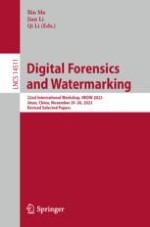2024 | Buch
Digital Forensics and Watermarking
22nd International Workshop, IWDW 2023, Jinan, China, November 25–26, 2023, Revised Selected Papers
herausgegeben von: Bin Ma, Jian Li, Qi Li
Verlag: Springer Nature Singapore
Buchreihe : Lecture Notes in Computer Science
